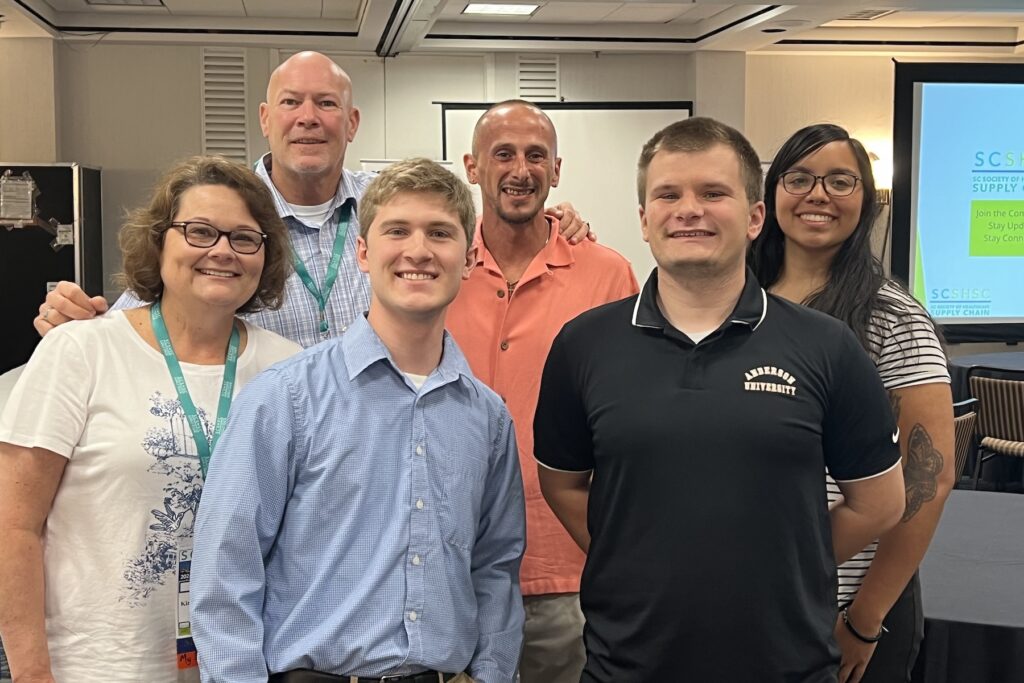Pictured at the at the SCSHSC Spring Conference June 1-3 in Myrtle Beach are, from left, Anderson University Professor of Business Dr. Kimberly Whitehead and students Spencer Keenan, Sam Morin and Jada Beach. Behind them, representing One Pass Access, are Randy Rowell, CEO, and Jason Hill, COO.
A student team from the Anderson University College of Business presented research conducted by Dr. Kimberly Whitehead’s logistics class this past spring on ways to improve how data that is vital to patients is communicated between healthcare facilities.
Anderson University students Jada Beach, Spencer Keenan and Sam Morin presented research at the South Carolina Society of Healthcare Supply Chain (SCSHSC) Spring Conference June 1-3 in Myrtle Beach. Dr. Whitehead expressed special thanks to Paulette Simmons and the staff at AnMed for their support providing an opportunity to present their findings before healthcare professionals gathered at the conference.
The research was titled “One Pass Access: Path of the Patient” and dealt with logistics behind the path that patients take as they move through the healthcare system. Students researched and documented changes in healthcare logistics and how to eliminate inaccuracies in patient data and create a one-piece flow of data transfer between providers and vendors.
In the presentation, Beach, Keenan and Morin talked about how EPIC, a system utilized for electronic medical records (EMR), has enhanced the sharing of patient information across the industry with its efficiency and accuracy of data, overcoming hurdles sometimes encountered in healthcare when hospitals and other healthcare facilities use different systems.
Keenan, a supply chain major minoring in Spanish whose primary interest is going into manufacturing, was interested in the differences of how logistics applied in healthcare. Beach, who is a rising senior majoring in Business Management and Supply Chain and a minor in Accounting, said the class looked at elective care and urgent care facilities as well as emergency rooms and a big hospital in general. Morin, a Supply Chain major and rising senior, was focused on walk-in clinics and how emergency care has changed in the last 10 years. He also helped gather information for the white paper.
“Obviously in manufacturing you deal mainly with assembly and other things like that, but in healthcare you’re dealing with doctors and dealing with nurses and people who don’t usually deal with the business side and are more around caring for the person,” Keenan said.
The presentation also dealt with the effects of COVID-19 on urgent care and elective health care—for example, the increased implementation of telehealth services.
The team’s report concluded that as the healthcare landscape continues to evolve, so does the need for more ways to treat patients, synchronous technology, and professionals in the field.
While EPIC is the main method of transferring EMR through healthcare facilities, not every facility utilizes it. Solutions outlined a “kickstart” facilitation of revenue cycle management, which is the method of transferring billing information between different medical facilities in a one-piece flow. Additionally, merging medical information for patients between hospitals can improve the Path of the Patient process for both patients and doctors.
“This was a unique opportunity. We got an opportunity to really understand a different mode of supply chain. That’s one of the unique things about that class we got to do—that there are a lot of different types of logistics and supply chain that we were learning in that class,” Keenan said. “Going into healthcare, it presented its own set of problems. It was very similar to supply chain in terms of manufacturing, but one approach to it you come out with unique issues.”

